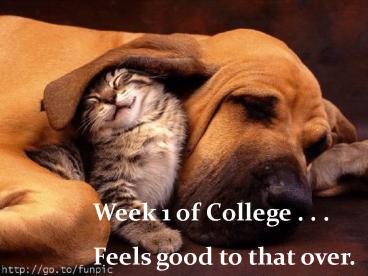Behavior and Handling PowerPoint PPT Presentation
1 / 28
Title: Behavior and Handling
1
Week 1 of College . . . Feels good to that over.
2
First . . .
- W2 Quiz
3
(No Transcript)
4
W2 Behavior Handling
5
Why study behavior/handling?
- Live comfortably with the domestic animal
- Reduce stress/increase productivity
- Maximize human safety
6
Outcomes. . .
- Describe categories of innate and learned
behaviors. - Explain principles of moving livestock with
minimal stress. - Identify some common methods of restraint and
control.
7
Behavior and HandlingReferences
Livestock Behaviour, Design of Facilitiesand
Humane Slaughter http//www.grandin.com/ By Dr.
Temple Grandin, Colorado State Univ.
- Animal Behaviour.net
- http//animalbehaviour.net/index.htm
- Website collection by Dr. Paul McGreevy, Univ of
Sidney.
US Meat Industry www.animalhandling.org/
8
Behavior
- The way animal reacts to a stimulus
- Behavior P G E GE
- The discipline of behavior is called what?
9
Learned Behaviors
- Habituation (desensitization)
- Conditioningcue, response, reward
- Extinction reinforcement not continued
- Imprinting
10
Categories of Innate Animal Behavior
- Ingestive
- Eliminative
- Shelter Seeking
- Investigative
- Agonistic
- Sexual
- Mother Offspring
- Social organization/ dominance hierarchy
11
Innate behavior can be used to accomplish lower
stress handling.
- Flight Response
- Gregarious
12
Understanding Flight Zone and Point of Balance
- Flight Zone and Point of Balance
- What are they? What defines them?
13
Flight Zone and Point of Balance
- Application is . .
14
- The Goal is for the animal to move itself with no
force and minimal stress - Consider
- distractions
- design
- restraint
15
Common Distractions
- Puddle reflections
- Chain noise
- Shadows
- High pitch noises
- Air drafts blowing in face
- Fan blade movement
- Objects on the floor
- Drain grates
- Misplaced light
- Dead end wall
- Disagreeable odors
16
Common Distractions
17
Common Distractions
18
- Distractions with purpose . . .
19
Design
20
Restraint and Control
21
(No Transcript)
22
and for canines
23
and for equines . . .
24
NPPC Presentation
- Swine Handling for Pork Producers
25
Homework for this week
- Reference http//animalbehaviour.net/index.htm
- Pick 2 1 from A-C, one from D-F.
- A.cattle, B.sheep, C. swine, D. horse, E. dog and
F. cat. - Read the chapter for each species listed and
highlight the following topics for - 1. Social organization and dominance hierarchies
- 2. Sexual behavior
- 3. Maternal-offspring behavior
- 4. Abnormal behavior pick one interesting
example
26
ERS (The Wheat Pressure Box)
27
(No Transcript)
28
(No Transcript)

